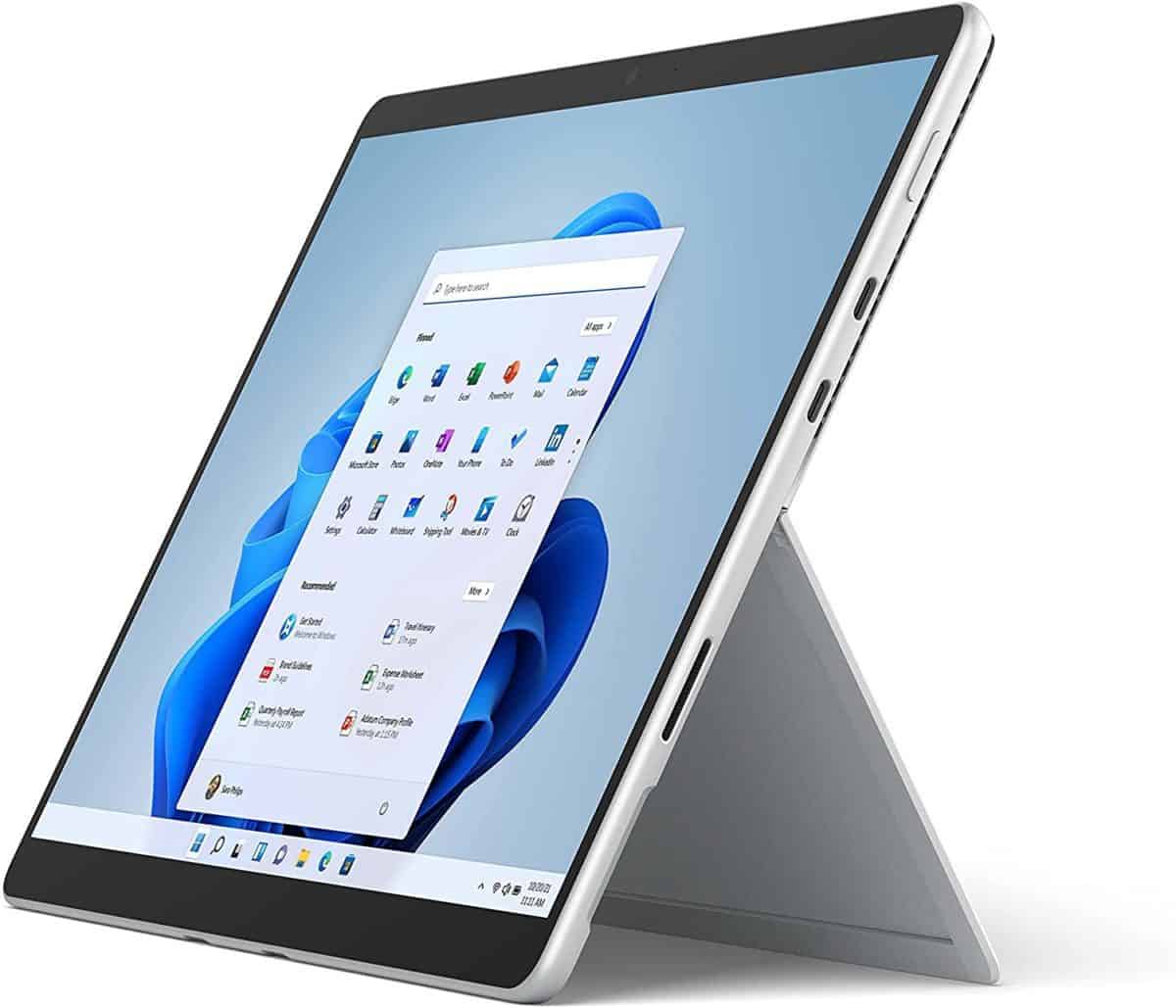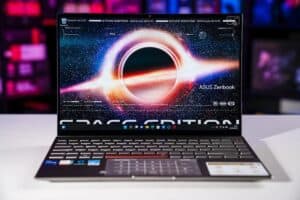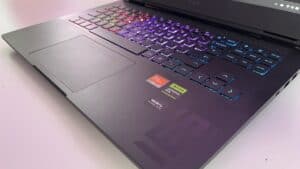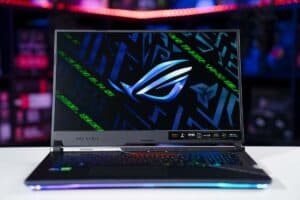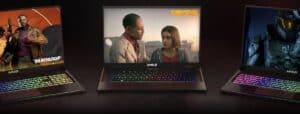Best laptop for working from home 2024
We talk through the contenders for best laptop for remote work in 2024

WePC is reader-supported. When you buy through links on our site, we may earn an affiliate commission. Prices subject to change. Learn more
In these post pandemic days where working remotely is a common phenomenon, looking for the best laptop for working from home has never been more relevant, and we’re here to help you make the right choice.
In this guide we’ve selected a range of different laptops suitable for remote work, whether you are a business person, creative, or student (though for more info on the latter check out our best laptop for students guide). They cover a range of different budgets, use-cases, and sizes depending on your particular needs, and we will discuss the positives and negatives of each in turn to guide you in your choice. You can read our things to look for when buying a laptop for remote work section further down the page for what you should bear in mind before you buy, or just dive straight into our in-depth reviews of each.
Best laptop for working from home: first look

MacBook Air 2022 (13.6″, M2)
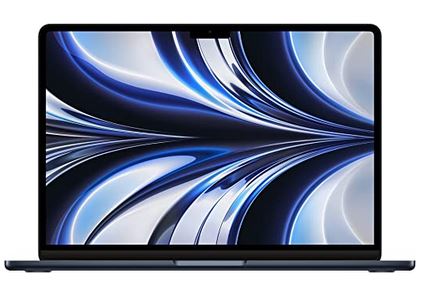
CPU & graphics
M2 chipset
RAM
8GB
Storage
256GB SSD
Max Refresh Rate
60Hz
Resolution
2560 x 1664
Screen Size
13.6-inch

Lenovo ThinkPad X1 Carbon Gen 9 (14″)
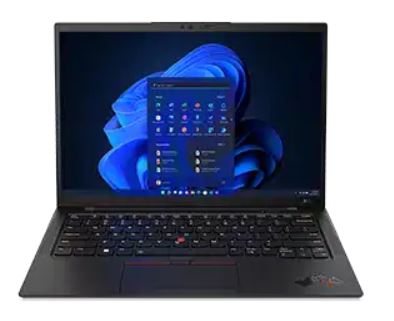
CPU
Intel Core i5-1135G7 / i7-1165G7 / i7-1185G7
graphics
Intel Iris Xe (iGPU)
RAM
up to 16GB LPDDR4x (4266MHz)
Storage
up to 1TB SSD
Max Refresh Rate
60Hz
Resolution
1920 x 1200 / 3840 x 2400
Microsoft Surface Pro 8
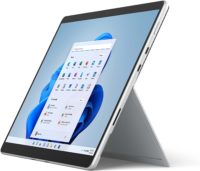
CPU
Intel Core i5-1135G7 / i7-1185G7
Display
13-inch, 2280 x 1920 pixels, 120Hz
RAM
8GB/16GB
Storage
128GB / 256GB / 512GB / 1TB SSD
Touchscreen?
Yes
Ports
2x USB-C with Thunderbolt 4, Surface connect port, Headphone jack

MacBook Pro 2023 (16.2″, M2 Pro / M2 Max)
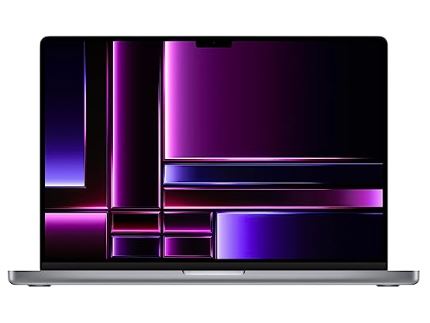
CPU & graphics
Apple M2 Pro / M2 Max
RAM
16GB / 32GB / 64GB / 128GB
Storage
512GB – 8TB SSD
Max Refresh Rate
120Hz (with ProMotion)
Resolution
3456 x 2234
Screen Size
16.2-inch
Dell XPS 15 (15-inch, OLED)
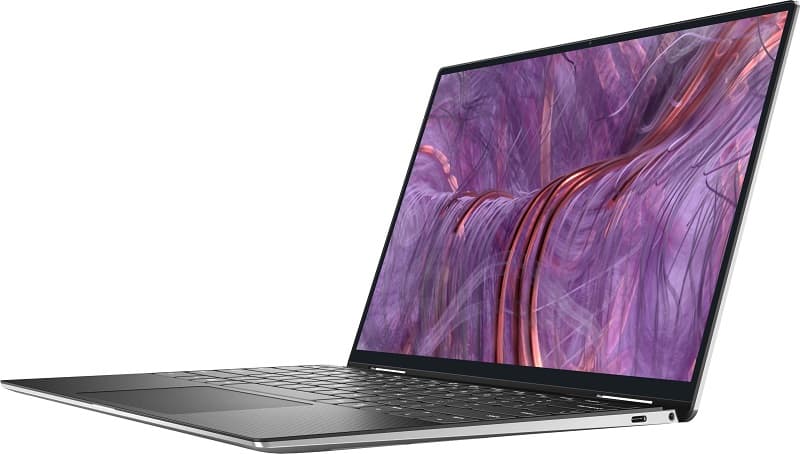
CPU
Intel Core i9-12900HK
Graphics
Nvidia GeForce RTX 3050 Ti
RAM
16GB / 32GB / 64GB
Storage
1TB / 2TB PCIe NVMe SSD
Screen Size
15.6”
Max Refresh Rate
60Hz

Lenovo IdeaPad 3 (Ryzen 5 5500U, 2021)
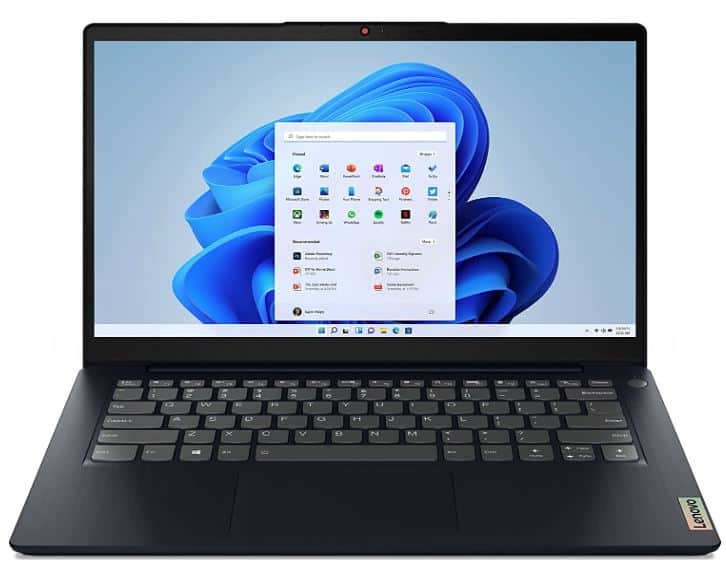
CPU
AMD Ryzen 5 5500U
Graphics
AMD Radeon 7 Graphics (iGPU)
RAM
8GB RAM
Storage
256GB SSD
Screen Size
14″
Max Refresh Rate
60Hz
In addition to the picks on this page, do be sure to have a little look at our best laptop deals and best gaming laptop deals pages. We continually update these with the latest offers so it’s a good idea to bookmark them and check back every month if you don’t see something you like immediately. You may also want to consider a Chromebook, in which case have a read of our Chromebook vs laptop guide.
Best laptop for remote work: Top Picks
Best laptop for working from home: in-depth review
Best laptop for working from home with Mac OS

MacBook Air 2022 (13.6″, M2)

CPU & graphics
M2 chipset
RAM
8GB
Storage
256GB SSD
Max Refresh Rate
60Hz
Resolution
2560 x 1664
Screen Size
13.6-inch
- fairly powerful M2 chipset
- bright and colorful screen
- excellent battery life
- superb build quality
- solid speakers
- solid webcam
- looks great
- light and portable
- most options limited to 8GB of RAM
- higher-specced RAM & SSD options can get pricey
- webcam notch on top of screen can be irritating
For the average home worker who is comfortable using MacOS, the Apple MacBook Air is a superb option for those after a portable but durable machine with an excellent keyboard and trackpad, a great battery life, and good quality webcam. Recently Apple launched the 15″ MacBook Air, which has very similar specs but costs around $100 more for the larger display, but the 13″ model remains the more popular choice for those on the mood (you can compare both in our 15 inch MacBook Air vs 13 inch MacBook Air guide). That being said, both sizes are very slim and light, and easily transported in a bag for workers on the move.
The M2 chipset (which comes with its own integrated graphics) is a pretty powerful performer for such a slimline machine and more than capable of dealing with non-demanding video editing workflows, plus a spot of light gaming. Despite its power, the chipset is also very energy efficient, meaning the MacBook Air has a fantastic battery life of around 11-13 hours of general usage and web browsing. The Liquid Retina IPS display has a nice high resolution and contrast, plus a peak brightness of 500 nits, which isn’t as good as the frankly ridiculous MacBook Pro’s peak brightness, but is still a goo, bright screen that you can use outdoors (as long as it’s not in direct sunlight).
As ever, being an Apple machine, these laptops aren’t exactly cheap, though we do think the MacBook Air is probably one of the better value models in their lineup. If you’re content with 8GB of RAM and the starting 256GB SSD size (which you could always supplement with an external hard drive if you wanted) then you can get the starting model for a fairly good price now, although additional RAM and SSD storage costs a lot and you can’t upgrade it after the point of purchase.

Lenovo ThinkPad X1 Carbon Gen 9 (14″)

CPU
Intel Core i5-1135G7 / i7-1165G7 / i7-1185G7
graphics
Intel Iris Xe (iGPU)
RAM
up to 16GB LPDDR4x (4266MHz)
Storage
up to 1TB SSD
Max Refresh Rate
60Hz
Resolution
1920 x 1200 / 3840 x 2400
- arguably the best laptop keyboard for typing
- matte screen minimises reflective glare
- excellent battery life
- very tough build quality
- additional security features
- somewhat pricey
- utilitarian aesthetic
The Lenovo ThinkPad series is the most well-respected range of business laptops on the market, and has a long running reputation for producing rugged laptops with additional file security and top-notch typing keyboards, plus matte screens that minimise glare in sunlight. Within this range there are various different sub-lines, with the most premium being the ThinkPad X1 Carbon series. The latest Lenovo ThinkPad X1 Carbon Gen 11 comes with the most powerful CPU spec options (Intel 13th gen laptop CPUs specifically) plus the latest DDR5 RAM. Prior to this you had the ThinkPad X1 Carbon Gen 10 with Intel 12th gen laptop CPUs and also DDR5 RAM. However, the option we think is probably the best remain the Gen 9, due to it being both more cost effective and also thanks to its superior battery life.
With the Gen 10 model you’ll likely get between 8-10 hours of battery duration on energy saving mode, depending on your exact specifications, which is nothing to be sniffed at and will suffice for a day’s work (depending on how long you work of course). This doesn’t match up to the extremely impressive 13-15 hours of the Gen 9 though, which is ridiculously good.
The keyboard is a unique design that’s halfway between a low-travel chiclet keyboard (similar to a MacBook for instance) and a tactile mechanical keyboard, with ergonomically shaped keys of perfect size and spacing to reduce typing errors. It’s arguably the best laptop keyboard for typing on the market. The trackpad is also solid, and the whole laptop is built to a literal military standard (with a MIL-STD 810G certified chassis) so can handle being dropped, shook around, and extreme changes of temperature for those with an itinerant lifestyle.
Security features include your standard Kensington lock, fingerprint sensor, and Windows Hello compatibility, in addition to TPM 2.0 data encryption for all your files, plus ThinkShield software – perfect for business people carrying sensitive documents. The laptop has a solid array of I/O ports coverage including an HDMI port and optional Nano SIM slot. Some options even come with an RJ-45 ethernet port.
Finally, if you think that the above price is a bit too steep for you, the ThinkPad E14 G3 is another 14-inch option that has inferior speakers and webcam compared to the X1 Carbon line, but still retains many of the benefits as far as the matte screen, rugged design, security features, and excellent keyboard go.
The best convertible laptop for working from home
Microsoft Surface Pro 8

CPU
Intel Core i5-1135G7 / i7-1185G7
Display
13-inch, 2280 x 1920 pixels, 120Hz
RAM
8GB/16GB
Storage
128GB / 256GB / 512GB / 1TB SSD
Touchscreen?
Yes
Ports
2x USB-C with Thunderbolt 4, Surface connect port, Headphone jack
- 2-in-1 functionality
- Sharp 120Hz screen with great sRGB color replication
- Solid speakers
- Good build quality
- Now available for a reasonable price
- No USB-A ports
- Optional keyboard & stylus/pen can get pricey
The Microsoft Surface Pro line is one of the most popular ‘convertible laptops’ on the market – essentially devices which have the functionality of both a laptop and a tablet. Unlike most 2-in-1 laptop designs where the bottom section hinges back around to create the tablet form factor, the Surface Pro is much closer in design to a tablet, but which comes with a detachable keyboard that you magnetically clip onto the bottom, plus a kickstand to prop it up. It has the benefits of the Windows operating system and works just like a laptop, but also has touchscreen functionality, stylus/pen support, and the portability of a tablet.
The Microsoft Surface Pro 8 isn’t the latest model of the Surface Pro line, that title goes to the Surface Pro 9, however the design between the two is very similar except for the CPU it comes with and we think that the older generation (released back in 2021) offers better value for those that don’t necessarily need a powerful CPU for their daily work (RAM is generally a more important feature for web browsing).
The newer 9th gen comes with options for either Intel 12th gen CPUs, or Microsoft SQ3 processors, whereas the Pro 8 is equipped with Intel 11th gen CPUs. Both have two USB-C ports and a headphone jack, plus a 13-inch, 2280 x 1920, 120Hz display. The resolution and pixel density (267ppi) is pretty high for a 13″ device which is nice, the brightness peaks at around 330nits which is adequate, but the color replication covers over 100% sRGB and it has a color accuracy of around 1.24 (average deltaE*00), which means it’s capable of light, accurate color workflows. We would have liked to have seen a USB-A port, as the lack of this does hamper functionality slightly, but you can always by a separate USB hub and plug it into the USB-C port.
Not every retailer sells the device with the keyboard or stylus included, so you need to be aware of this, and these additional features can be a bit expensive, but given the Surface Pro 8 is a bit older now, the price of the device generally has reduced quite a bit.
The best MacOS laptop for creatives working from home

MacBook Pro 2023 (16.2″, M2 Pro / M2 Max)

CPU & graphics
Apple M2 Pro / M2 Max
RAM
16GB / 32GB / 64GB / 128GB
Storage
512GB – 8TB SSD
Max Refresh Rate
120Hz (with ProMotion)
Resolution
3456 x 2234
Screen Size
16.2-inch
- very powerful M2 Pro / M2 Max chipset options
- excellent peak brightness and great color replication
- the best battery life of any laptop
- superb build quality
- the best speakers of any laptop
- good webcam
- looks great
- light and portable
- Very expensive
- Adding RAM & SSD to the base spec is pricey
- Still limited compared to Windows machines when playing games
The 2023 MacBook Pro 16 is a very powerful machine that’s ideal for high-end creatives workflows, including video editing and graphics design. This 16-inch MacBook Pro comes with options for either Apple M2 Pro or M2 Max, which are both have considerably more processing power (from the CPU, GPU, and neural-net cores) than the standard Apple M2 chip that you’ll find in the MacBook Air. Indeed for a normal, general use office laptop they’re pretty excessive, and you’d be better opting for the far cheaper (and 1.4lbs lighter) MacBook Air instead as this is an expensive device.
The M2 Pro chip is best for those with moderately demanding editing workloads (be they photo/video/audio) whereas the M2 Max is only for really strenuous workloads, such as heavy CAD rendering or the like, or multiple programs running simultaneously. Both chips are certainly powerful enough to play games, although the number of games you can play on Mac is still a bit limited.
The Retina display in the Apple MacBook Pro comes with the souped-up XDR variant that has a ridiculously high peak brightness of 1000nits, or up to 1600nits when viewing HDR content, which is the brightest we’ve seen in any laptop. Additionally the screen has a ProMotion features that increases the maximum refresh rate to 120Hz – useful for video editing as well as gaming. In terms of resolution, the screen also has a higher pixel per inch than the standard Retina on the MacBook Air (254ppi vs 224ppi).
Compared to the MacBook Air you get an additional Thunderbolt 4 / USB-C slot, plus an HDMI socket and SDXC card reader – all very useful for media professionals. Additionally it comes with Wi-Fi 6E, as opposed to the Wi-Fi 6 support of the MacBook Air, meaning better connection and data bandwidth.
The best Windows laptop for creatives working from home
Dell XPS 15 (15-inch, OLED)

CPU
Intel Core i9-12900HK
Graphics
Nvidia GeForce RTX 3050 Ti
RAM
16GB / 32GB / 64GB
Storage
1TB / 2TB PCIe NVMe SSD
Screen Size
15.6”
Max Refresh Rate
60Hz
- 100% sRGB & 100% DCI-P3 color coverage
- OLED display with superb contrast ratio
- very high peak brightness
- 16:10 aspect ratio gives more vertical space
- great keyboard & touchpad
- Thunderbolt 4 & SD card reader support
- superb build quality & aesthetics
- quiet fans
- thin & portable
- expensive
- no USB-A / USB-B ports
This Dell XPS 15 released comes with a terrific OLED screen with fantastic color replication and an aesthetic design that rivals the best MacBooks. You get various CPU and GPU options, going all the way up to the RTX 3050 Ti dedicated graphics card, plus ample RAM and SSD storage options.
The 16:10 3456 x 2160 (aka 3.5K) screen is great for viewing either documents, web browsing, or watching creative media on. As with every OLED display, you get ludicrously high contrast ratio, plus in this case 100% sRGB and 100% DCI-P3 coverage, making it a great choice for color workflows using software in Windows OS. With a peak brightness of 500 nits, it doesn’t quite match up to the exceedingly high MacBook Pro brightness, but is still up there with the MacBook Air.
It’s thin, light, portable, well-made and has a good quality keyboard and trackpad. It comes with both USB-C/Thunderbolt 4 ports plus an SD card reader (ideal for creatives) however, the biggest downside of this laptop is the lack of USB-A ports. This can be got around with by purchasing a separate USB hub to plug into one of the USC-C slots, but it’s a bit of an annoying drawback in our opinion.
Besides this though, the only real downside of this machine is the price, but you can often find models on sale (particularly renewed units) for a reasonable price. If you’re looking for a Windows with a bit more power for those more demanding rendering tasks, then you may also want to consider the Gigabyte Aero 16 XE4 with 4K AMOLED display, Intel Core i7-12700H CPU and Nvidia RTX 3070 Ti graphics card.
Best budget laptop for working from home

Lenovo IdeaPad 3 (Ryzen 5 5500U, 2021)

CPU
AMD Ryzen 5 5500U
Graphics
AMD Radeon 7 Graphics (iGPU)
RAM
8GB RAM
Storage
256GB SSD
Screen Size
14″
Max Refresh Rate
60Hz
- solid battery life
- good build quality for the price
- full-size keyboard
- good webcam & mic for the price
- SD card reader
- smallish touchpad & keys maybe a bit stiff for some
- no USB-C charging
- narrow color gamut
The 14-inch Lenovo IdeaPad 3 comes in many different variants, but this 2021 model equipped with AMD Ryzen 5 5500U processor is a great budget offering for a remote working laptop, available at the time of writing for somewhere in the $400-$500 price range. Obviously if you’re only paying this much you have to expect sacrifices in certain areas – the screen for instance has pretty poor color replication and contrast, meaning it’s unsuitable for any color-based workflows, so creatives doing this sort of work will want to look elsewhere, however it does have a reasonable 300 cd/m² peak brightness for general use.
Besides this, there are a great many positives to this laptop: the CPU is decently powerful for an older mid-range Ryzen CPU, and means the energy efficiency of the laptop is pretty solid: you can expect up to 9 hours on battery saving mode for non-strenuous use, sufficient for the average working day. You can also partially upgrade the memory (which comes with 4GB soldered and another 4GB of upgradable RAM) to a maximum of 12GB, which is pretty unusual for a laptop this cheap.
For such a budget device, the build quality is fairly decent – there’s a bit of screen flex but besides this it’s well put together, including around the hinge section where it particularly matters. The keyboard is a bit on the stiff side and could cause fatigue after long typing sessions, which may put some people off, though this depends a bit on your subjective preference. The trackpad is a tad small as well, though at least both this and the keys feel sturdy and you get a full-size keyboard (with numpad included – good if you work with numbers).
Although the webcam is only 720p, and inferior to the other selections on this page, it’s actually above what we’d expect for a laptop in this price range, though the microphone audio is pretty quiet. The selection of ports includes two USB-A ports, one USB-C port, and a SD UHS card reader, and though you don’t get charging or display output through the USB-C port, this is okay on this budget.
Things to consider when choosing the best laptop for remote work
Before you pull the trigger on a laptop purchase, make sure you consider the following factors. These should be at the forefront of your mind when shopping for a new laptop for a new laptop for working remotely.
Memory
The GB of RAM is generally more important for general use / office machines than the power of the processor and certainly of the GPU/integrated graphics. Web browsers are very RAM hungry and if you’re a person that likes to open a lot of tabs or have multiple programs running simultaneously then you’ll want a good amount. 8GB is the minimum we’d advise these days for most people and16GB would be the ideal amount for the vast majority of people. If you’re interested in running demanding creative software: video editing, graphic design, animation and the like then we’d suggest 16GB as a minimum with 32GB being the ideal.
Battery duration
Although the chances are you’ll likely be plugged into a power socket if you’re sat at home, a long battery life is still a welcome feature to have in a remote work laptop, in particular if you’ll be working away from home at times and out on the move. The minimum you’d want in a non-gaming laptop is probably around 7 hours on battery saving mode, but ideally you’d want a machine that could last the working day.
Wi-Fi & Ethernet connection
Maintaining a good internet connection is generally one of the most important things when it comes to working from home in most jobs, and the majority of people will be using Wi-Fi connection to do this. The latest Wi-Fi standard is 6e but you’ll need a WiFi 6e card in your laptop in order to utilise the benefits of this. Wi-Fi 6e adds an additional ‘6-GHz band’ to the frequencies outputted by Wi-Fi 6 which basically reduces congestion if multiple people are using the same network connection – improving reliability and meaning less lag for everyone on the connection.
The vast majority of WiFi cards are 6 or 6e, and though the odd WiFi 7 cards are popping up in newer laptops, it won’t be until the Wi-Fi 7 release date when the new standard goes live (which could be as later as Q1 2025) until they actually perform better than a WiFi 6e card.
Ethernet connection remains the best way to maximise your bandwidth and connection reliability, however few laptops have an ethernet port; some do though – so make sure to check the specs!
Webcam
You’re going to want a decent camera for all those Teams meetings and the like (assuming that’s the type of work you do at home). We’ve tried to pick selections with at least a reasonable minimum standard of camera quality before including them in this list, though some are better than others. Just because a camera has 1080p resolution does not mean that it’s of good quality, although in most cases 1080p is preferable. Alternatively, you can pick up a separate webcam.
Final Word
We trust that you now have all the info you need to find the best laptop for working from home for your needs. If you didn’t find the remote work laptop you were looking for, do take a look at our various other laptop guides in the dropdown menu above, including our best gaming laptop, best OLED laptop, best 4K laptop and more.
Best laptop for working from home FAQs
What kind of laptop do I need to work remotely?
There are plenty of options when it comes to remote work laptops, and the one that’s best suited to you depends on what kind of work you do. For people who are doing standard office work, you’ll want a machine with a decent amount of RAM, good keyboard, Wi-Fi connection and ideally a respectable webcam. If you’re a creative you’ll probably want to prioritize the screen quality and color accuracy, and if you’re doing rendering workflows or workstation tasks then you’ll want a solid CPU, GPU, and even more RAM.
Read our guide for some suggestions covering all these use cases.
Is 8 GB RAM enough for working from home?
8GB of RAM is sufficient for most people whose work consists of web browsing plus using Microsoft Office applications like Word and Excel, or the equivalent from a different brand.
For those who really want to maximise the number of tabs they can have open in their browser, or who need to use more demanding software, 16GB of RAM is what we’d recommend to be on the safe side.

